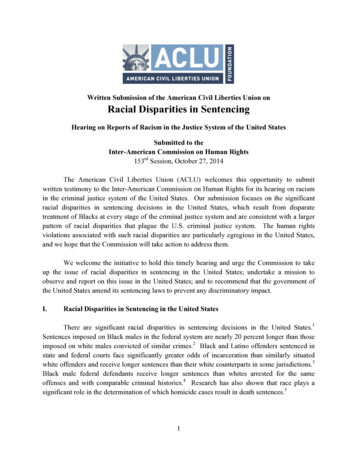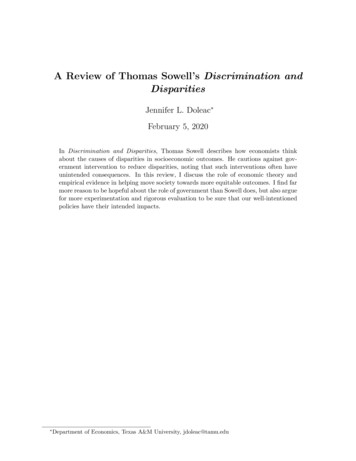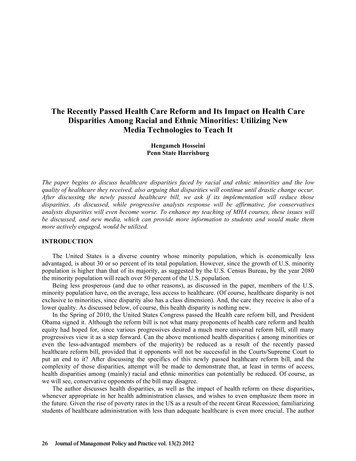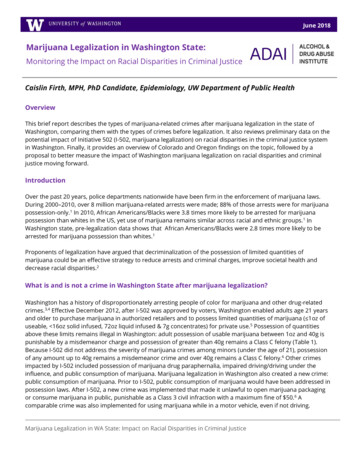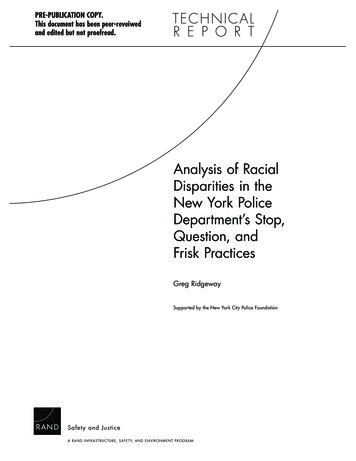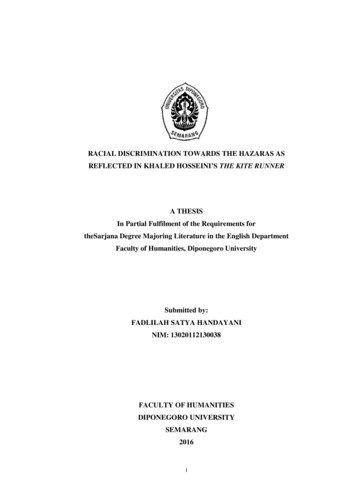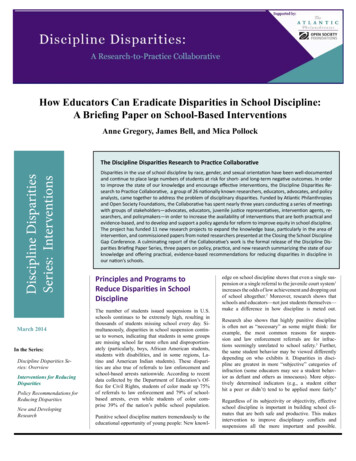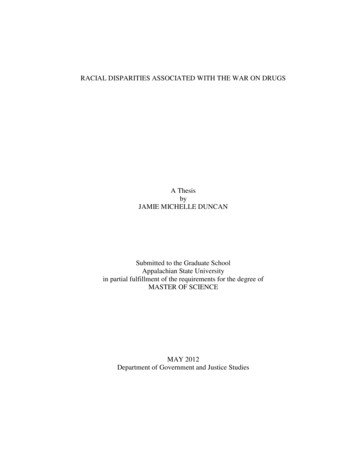
Transcription
RACIAL DISPARITIES ASSOCIATED WITH THE WAR ON DRUGSA ThesisbyJAMIE MICHELLE DUNCANSubmitted to the Graduate SchoolAppalachian State Universityin partial fulfillment of the requirements for the degree ofMASTER OF SCIENCEMAY 2012Department of Government and Justice Studies
RACIAL DISPARITIES WITHIN THE WAR ON DRUGSA ThesisByJAMIE MICHELLE DUNCANMay 2012APPROVED BY:Dr. Daniel S. MurphyChairperson, Thesis CommitteeDr. Matthew RobinsonMember, Thesis CommitteeDr. Kenneth MullenMember, Thesis CommitteeDr. Brian EllisonChairperson, Department of Government and Justice StudiesEdelma D. HuntleyDean, Research and Graduate Studies
Copyright by Jamie Michelle Duncan 2012All Rights Reservediii
ABSTRACTRACIAL DISPARITIES WITHIN THE WAR ON DRUGS (May 2012)Jamie Michelle Duncan, B.S., Appalachian State UniversityM.S., Appalachian State UniversityChairperson: Daniel MurphyThis research examines the harmful effects of the war on drugs with specificimportance placed on racial inequalities. I explore the current drug war in an effort topresent statistical observation of those arrested, sentenced, and incarcerated for drug-relatedoffenses. As a means to better understand the racial disparities that exist within the criminaljustice system, I draw upon several key theorists to lay foundation for the discussioncontained herein. Upon presenting statistical data from a myriad of sources, I will explorethe outcome variable of racial disparity as result of the war on drugs.iv
DEDICATIONThis paper is dedicated to my mother, who has always pushed for me to strive for mybest. Her words of wisdom have helped me through some of the most trying times of mylife, and without her none of this would have been possible. I would also like to dedicate thiswork to the faculty of the Government and Justice Studies Department at Appalachian StateUniversity. The knowledge I have obtained during my college career will certainly stay withme forever.v
LIST OF TABLESTable 1. Statistics of African-Americans Processed within the Criminal Justice System. 23Table 2. Percentage of individuals arrested for the sale and manufacturing of illicit drugs versus thepercentage of individuals arrested for possession of illicit drugs in 2010. 37vi
LIST OF FIGURESFigure 1: Lifetime Drug Use by Race, Ages 12 and Older . 26Figure 2: United States Rates of Adult Drug Arrest Rates by Race, 1980-2000. 35Figure 3: Racial Disparity in Drug Sentencing . 43Figure 4: Changes in Prison Population . 49Figure 5: Federal Drug Control Spending on Prevention, Treatment, and Domestic Enforcement(FY11 Enacted) . 57vii
TABLE OF CONTENTSAbstract . ivDedication . vList of Tables . viList of Figures . viiIntroduction . 1Methodology . 4Theoretical Foundation. 5Durkheim . 7Conflict Theory . 8Pyrrhic Defeat Theory . 11Moral Panic Theory . 13Labeling Theory . 16Origins of the War on Drugs . 19Media . 24Police . 31Courts . 39Corrections . 46Problems as a Result of the War on Drugs . 50Goals of the Current Office of National Drug Control Policy. 56Conclusion . 59Alternative Programs . 61Appendix A . 64Appendix B. 65Appendix C. 66Vita . 74viii
INTRODUCTIONIn excess of forty years prior to the present debacle, President Richard Nixon declareddrug abuse as “public enemy number one in the United States” (Frontline, 2000).Reinventing a drug war that had been dormant since the 1930s with the creation of theBureau of Narcotics, Nixon managed to instill enough fear into the public that drasticchanges began to take place. Following suit, in 1986 President Reagan officially declared anational “war on drugs” (Frontline, 2000). Since then, the United States has spent an everincreasing amount of time and money attempting to combat drug use and drug abuse(Robinson & Scherlen, 2007).Since its reinvigoration under President Nixon forty years ago, the war on drugs haspervaded many facets of human life. An element that has become of paramount importancetoday, as it relates to the war on drugs, is the issue of race. From arrest, to sentencing, toincarceration, and on to reintegration, race has played a significant role in the war on drugs.Although the architects of the war on drugs may not have intended for the racial disparities,their actions have nonetheless left severe inequalities within the criminal justice system.Barry McCaffrey, President Clinton’s drug czar, said in 1996, “It is truly a war without aclear enemy. Anything waged against a shapeless, intangible noun can never truly be won”(Suddath, 2009). Can you possibly have a war on drugs? The answer is no; rather, it is a waron United States citizens with racial disparities as a primary component.Given its forty year reign, it is essential to analyze the war on drugs in an effort toassess its validity. Robinson (2005) states that “the war on drugs is a phrase used to describe1
the American approach to reducing drug use and abuse in the United States” (p. 311). If thewar on drugs had accomplished stated goals, there would be a significant decline in drug usethroughout America. It is of paramount importance to examine what the war on drugsintended to do in light of which individuals have fallen prey to its mission. Morespecifically, Robert Merton’s construct of unintended consequences is applicable. Merton(1936) states that the actions of people, and especially of government, often have effects thatare unintended or unanticipated. With rising numbers of individuals in prisons and jails fordrug-related offenses, it is evident that the war on drugs is a clear example of unintendedconsequences, especially in its failure to reduce drug use.The “war on drugs” has created a bureaucratic behemoth of courts, jails, and prisonsthat have done little to decrease the use of drugs while doing much to create confusion andhardship in families of color and urban communities (Mauer, 2001). Inevitably, the war ondrugs has managed to do more harm than good over the past several decades. In fact, Mauer(2001) notes that since 1972, the number of people incarcerated has increased five-foldwithout a comparable decrease in crime or drug use. Although the Obama administration haspledged to address many of these concerns, progress has been slow; in fact, in some areas ithas been nonexistent (Human Rights Watch, 2011).The highly controversial issue of fighting a war against an intangible enemy has ledto the state of affairs exemplified today. As of June 2009, the United States continues tohave both the largest incarcerated population (2,297,400, a decrease of 0.5 percent sinceDecember 2008) and the highest per capita incarceration rate in the world (748 inmates per100,000 residents) (Human Rights Watch, 2011; The Pew Center on the States, 2008).Similarly, the Justice Policy Institute (2008) reports,2
The United States leads the world in the number of people incarcerated in federal andstate correctional facilities. Approximately one-quarter of those people held in U.S.prisons or jails have been convicted of a drug offense. The United States incarceratesmore people for drug offenses than any other country. With an estimated 6.8 millionAmericans struggling with drug abuse or dependence, the growth of the prisonpopulation continues to be driven largely by incarceration for drug offenses (p. 1).Given the high numbers of individuals incarcerated for drug offenses, it is necessary toreexamine the war on drugs in an effort to develop alternative methods such as rehabilitation,treatment, and reintegration. The Human Rights Watch (2010) reports that a national AngusReid poll reveals that 65 percent of Americans think the decades long effort of the war ondrugs has been a failure. Despite the federal government’s claim that the drug war isworking, it has proven to be another failed policy yielding serious consequences to anyone inits way, especially minorities.3
METHODOLOGYThe research objective shall draw on both qualitative and quantitative research thatcan be found within the literature. This specific data is best suited for the present analysis, inthat I shall be able to build upon an existing body of research. Supporting literature in thefield is essential to consider, for it will assist in laying the groundwork for future implicationsthat arise from findings herein. More specifically, traditional archival research shall be theprimary means of collecting data. Due to time constraints during this phase of my research,obtaining primary data is unfeasible. However, in utilizing secondary data, I shall be betterequipped to present the linkage between drug arrests, convictions, and punishments that ariseas a result of the war on drugs, as well as the race of individuals that are being processed. Inorder to analyze and interpret my findings, I shall employ several theoretical perspectives asfoundational constructs.4
THEORETICAL FOUNDATIONThis section shall focus on the key theories that can be used as foundationalgrounding in understanding elements of the war on drugs. More specifically, this section ofanalysis will incorporate several key concepts related to the criminal justice system. Conflicttheory is grounded in the notion that individuals in power are making rules that govern oursociety, often for the benefit of themselves. From this perspective it can be argued that thepowerful architects of the drug war are responsible for the racially disparate laws that arebeing enforced today. In constructing these laws, they ensure that the powerless groups insociety are oppressed.One way of maintaining power is through the media, which determine what theaudience will see, as well as how it will be portrayed. Thus, the media are capable ofpromoting fear at the level of the general public, thereby sustaining the war on drugs.Expanding upon this construct, I shall explore the theoretical foundation of moral panic asimpetus to the drug war. Moral panic theory will aid in efforts to exemplify how society canbe moved to moral panic if they believe social order may be at risk. With this theory, I shallexplore the ways in which groups of individuals demonize other groups. In addition, I shallexplore Emilé Durkheim’s perspective that the “bad” defines the “good,” and that those thatsee themselves as “good” resort to using the “bad” as scapegoats. Lastly, I will highlight theconcept of pyrrhic defeat theory as a means to explain how those in power benefit from thefailure of the war on drugs. I will briefly mention labeling theory as a means to describe the5
hardships of individuals who have been stigmatized by the war on drugs. These theories willassist in laying the theoretical foundation for the remainder of the paper.6
DurkheimThe notion that crime serves important functions for a society was developed bysociologist Emilé Durkheim (Reiman, 1998, p.7). According to Durkheim, societies mayproduce behavior that the majority wants to eliminate. In other words, crime serves afunction in society to set limits and place moral worth on subjects. A community not onlymakes good of unacceptable behavior, but it positively needs unacceptable behavior(Reiman, 1998, p. 46). Further, Durkheim argues that crime is an essential element forsociety to exist in that there has never been a society absent of crime. Durkheim’s theoryimplies that the “bad” behavior of individuals in society define the “good” behaviors, furthercreating differences among citizens. This view becomes the hypothesis that the Americancriminal justice system fails to reduce crime because a visible criminal population is essentialto maintaining the “boundaries” (Reiman, 1998, p. 47).According to Durkheim, crime is a functional aspect of society and serves manydifferent roles. In fact, Durkheim believed that some level of crime is normal and evennecessary for several reasons (Lanier & Henry, 2004, p. 237): Even in a well-ordered society, crime is necessary to remind thecommunity of its values and standards Crime serves to create a sense of solidarity among law-abidingcitizens; the criminal or crime presents an occasion to bring peopletogether to celebrate their values by denigrating those they oppose Society can make moral messages about which rules are mostimportant by adjusting the severity of punishmentThe deviant individual violates rules of conduct which the rest of the community holds inhigh respect. When these people come together to express their outrage over the offense andto bear witness against the offender, they develop a tighter bond of solidarity than existed7
earlier (Erikson, 1966, p.4). Durkheim suggests that crime performs a needed service tosociety by drawing people together in a common stance of anger and indignation.Durkheim’s theory exemplifies the fact that crime is necessary in order forindividuals in a community to feel better about themselves for being “good.” This notionclearly implies that, in order to be “good,” someone must ultimately play the role of the“bad.” Kai Erikson (1966) has suggested in his book, Wayward Puritans, that societiesderive benefit from the existence of crime and thus there is reason to believe that socialinstitutions work to maintain rather than eliminate crime (as cited in Reiman, 1998, p.45). Inother words, societies may promote behavior that is contrary to the collective conscience. Bymaintaining crime, society is placing value on certain groups of individuals, furtherseparating distinct social classes within society.Linking Durkheim’s theory to the war on drugs, it is evident that certain individualswithin society are used as scapegoats. For instance, a disproportionate number of minoritiesare arrested and incarcerated each year for low-level, non-violent drug offenses. Accordingto Durkheim, these individuals represent a subset of the population that can be viewed asbeing deviant. Upon distinguishing these individuals as “deviants,” other members of societyare unified in their actions and beliefs, further exemplifying the fact that individuals beingprocessed for drug-related offenses are excluded from the solidified “good” group of citizensin society. Durkheim’s concept is especially relevant for the race related minority populationin particular.Conflict TheorySocial conflict has been defined as “a struggle over values or claims to status, power,and scarce resources, in which the aims of the conflicting parties are not only to gain the8
desired values but also to neutralize, injure, or eliminate their rivals” (Coser, 1968, p. 232).In our society, once an individual has obtained status and power, there is an inclination tomaintain this power and oppress anyone that serves as an obstacle in this quest. The morepowerful groups use the criminal justice system to maintain their dominant position and torepress groups or social movements that threaten it (Liska, 1992). More specifically, Colvinand Pauly (1983) report that the more powerful groups have the most influence in shapingthe legal order to their interests, while those groups lacking social power are most frequentlysubjected to criminal status (p. 521). This Marxist criminology approach concludes thatthrough maintaining their privilege, those in power further exclude certain groups in society.In our society, power in concentrated in the hands of the few. As Lanier and Henry(2004) note, this class-based economic order is maintained by a criminal justice system thatserves the interests of the wealthy at the expense of the poor (p. 259). This notion can bebest viewed within Jeffrey Reiman’s book, The Rich Get Richer and the Poor Get Prison.Reiman (1998) notes that competing interests within a society lead to a small number ofindividuals in positions of power. Therefore, the stage is set for conflict between a smallgroup who control all the power and a larger group who challenge the system. Society iscomposed of many different groups, which have differing and competing interests, values,and norms (Lanier & Henry, 2004, p. 263). Ultimately, the conflict between groups or socialclasses in society is unavoidable; it is the conflict between these groups that lays thefoundation for conflict theory.Conflict criminologists draw their analysis, in large part, from the ideas of MaxWeber. Lanier and Henry (2004) state that conflict theorists see inequality based ondifferences in wealth, status, ideas, religious beliefs, and so forth; these differences result in9
the formation of interest groups that struggle with each other for power (p. 261). Given thefact that there are limited resources available in society, competition for these resourcesundoubtedly leads to conflict among individuals. More specifically, groups that have powerover others (whether economic, social, ideological, moral, or religious) typically define whatbehaviors are criminal and which are not; thus, laws reflect the values and interests of thedominant group(s) (Lanier & Henry, 2004, p. 262). In essence, the laws created by those inpower typically target powerless individuals, further adding power to the dominant groups.This concept can be further explained in relation to the war on drugs in the sense that theindividuals in power are creating such severe punishments for low-level drug offenses. Thepowerless individuals being targeted by the war on drugs do not have the means to combatthose in positions of power; therefore, the powerless individuals are the ones who suffer themost.Disempowered groups in society feel resentment toward, and alienated from, asystem that excludes them (Lanier & Henry, 2004, p. 260). The criminal justice system canbe viewed as an apparatus that operates on behalf of those in power, with a mission tooppress a certain population of individuals in society. More pointedly, the war on drugs hasserved as a tool used by the dominant group in order to oppress numerous minoritycommunities. In oppressing minority communities under the premise of fighting the war ondrugs, those in positions of power have created and maintained a social divide in society.According to Weber, conflict is likely when only a few are allowed access to positions ofprivilege or when social mobility to these positions is highly restricted (Lanier & Henry,2004, p. 265). In turn, this conflict creates or reinforces tension and resentment among thosewithout power and privilege.10
Pyrrhic Defeat TheoryUnlike Durkheim’s theory, the Pyrrhic defeat theory explains the persistence offailing criminal justice policy, rather than its origins (Reiman, 1998, p. 159). Reiman (1998)states that a “Pyrrhic victory” is a military victory purchased at such a cost in troops andtreasure that it amounts to a defeat. The Pyrrhic defeat theory argues that the failure of thecriminal justice system yields such benefits to those in positions of power that it amounts to asuccess (Reiman, 1998, p.5). In order to keep their position, those in power imply that thereal threat to Americans comes from law-breaking poor minorities. Reiman (1998) notes thatthis leads Americans to demand harsher doses of “law and order” aimed mainly at the lowerclasses.The Pyrrhic defeat theory creates the view that the failure of criminal justice policybecomes intelligible when we see that it creates the “reality” of crime as the work of the poorand thus projects an image that serves the interests of the rich and powerful in Americansociety (Reiman, 1998, p.7). In other words, we are accustomed to fear poor individualsbecause we are told that their crimes are the “worst” crimes; the media, and the powerfulindividuals who control the media, have a significant role in determining what we deem asthe “worst crimes.” Reiman (1998) concludes that specifically, those who are the biggestthreat to society are males from urban communities who are young, black and poor. Thisimage, created by lawmakers and the media alike, sends citizens into a state of fear and panicdirected at anyone who falls into these categories.By failing to define the dangerous acts of the powerful as crimes, and neglecting toenforce laws against this group, the criminal justice system fails to protect people from themost serious dangers (Reiman, 1998; Robinson & Murphy 2008). This simply means that11
very serious crimes committed by individuals in power are often overlooked. How can thisbe? The answer lies within the notion that the individuals in power are the ones defining theterm crime. As long as it appears that law enforcement is tough on crime by arresting poor,urban, black males, then society is at ease while the true criminals go unnoticed.According to Reiman (1998) the Pyrrhic defeat theory is composed of five differenthypotheses: Of the decision of the legislators: that the definitions of crime in thecriminal law do not reflect the only or the most dangerous of antisocialbehaviors. Of the decisions of the police and prosecutors: that the decisions onwhom to arrest or charge do not reflect the only or the most dangerousbehaviors legally defined as “criminal.” Of the decisions of juries and judges: the criminal convictions do notreflect the only or the most dangerous individuals among thosearrested and charged. Of the decisions of sentencing judges: that sentencing decisions do notreflect the goal of protecting society from the only or the mostdangerous of those convicted by meting out punishments proportionateto the harmfulness of the crime committed. Of all these decisions taken together: that what criminal justice policydecisions (in hypotheses 1 through 4) do reflect is the implicitidentification of crime with the dangerous acts of the poor, anidentification amplified by media representations of crime (p. 67-68).These hypotheses, coupled with the fact that the criminal justice system is failing inavoidable ways to reduce crime, create the backbone of the Pyrrhic defeat theory asexplained by Reiman. Institutions designed to fight crime instead contribute to its existence(Reiman, 1998, p. 7). This repressive function of the criminal justice system implies thatsome crimes can be overlooked if the price is right. Additionally, Moore and Elkavich12
(2008) report that the politics of the war on drugs deem skyrocketing incarceration rates as asign of success, not failure.Pyrrhic defeat theory, as described by Reiman, can be best realized upon analyzingthe war on drugs. The failure of the war on drugs has actually amounted to a success forindividuals in power given that more serious crimes are often overlooked in an effort tocombat minor drug usage at the street level. For instance, the war on drugs can be viewed asa success for those in power given that these individuals are able to get away with morecriminal activity due to the fact that such importance is placed on policing the war on drugs.Essentially, the powerful can actually profit from crime.Moral Panic TheoryMoral panics occur when a condition, episode, person or group of persons emerges tobecome defined as a threat to societal values and interests; its nature is presented in a stylizedand stereotypical fashion by the mass media (Cohen, 1980, p. 9). In other words, the massmedia, which is controlled by the powerful, facilitates creating fear among the public to thedegree that moral panics arise out of trivial and often insignificant issues. Robinson andScherlen (2007) reiterate this notion reporting that when an objective social problem is blownout of proportion, the result can be a “moral panic” (p. 10). By creating these moral panics,the mass media are capable of oppressing specific minority groups in an effort to maintain apolitical agenda. As a part of the political and economic elite, news agencies facilitate moralpanics by relying on public officials as information sources and portraying those who wouldconfront existing structures, policies and institutions as deviant, disgruntled or representativeonly of a fringe minority (Denham, 2008). Therefore, anyone viewed as going against thesemoral panics are deemed as deviants and face severe repercussions in the future.13
By amplifying, or drawing broader attention to deviant behaviors, groups with powerconfirm accepted moral boundaries (Young, 1977). As previously noted, this conceptreaffirms the notion that those in power define what is morally acceptable. Jenkins (1998)also reports that moral panics often emanate from a key event and involve a familiar issue.In utilizing certain events throughout history, politicians and lawmakers are able to use themedia as a sounding board to instill enough fear into the public that change is brought about.Moral panic theorists argue that society is characterized by a variety of commonsenseperceptions about crime and drugs that result in community intolerance for such behaviorsand increased pressure for punitive action (Jenkins, 1994).Dramatic exemplars, which facilitate both profit maximization among news agenciesand legislative proposals among public officials and political elites, assist in generating moralpanics when empirical evidence may offer little or no support (Denham, 2008, p. 957). InAmerica, crime sells; therefore, news organizations that are assured a certain topic willincrease viewers will promote an idea that may lack empirical evidence. In conceptualizingmoral panics, Goode and Ben-Yehuda (1994) identify five criteria: A heightened level of concern about an issue should appear, That concern should contain a certain amount of hostility toward acertain group of individuals who are perceived as a threat to society, A consensus in society should consider the real threat, Even though reaction to the issue is largely disproportionate, Lastly, moral panics are generally volatile; tending to arise rapidly andtypically fading in similar fashion.In other words, moral panics typically arise out of a level of concern about a particular issue,which ultimately leads to feelings of hostility towards certain groups in society. These14
exaggerated news stories leave Americans under the impression that an insignificant issuemay be a serious threat to democracy.Because moral panics “typically involve an exaggeration of a social phenomenon, thepublic response also is often exaggerated and can create its own long lasting repercussionsfor society in terms of drastic changes in laws and social policy” (Escholtz, 19
1 INTRODUCTION In excess of forty years prior to the present debacle, President Richard Nixon declared drug abuse as "public enemy number one in the United States" (Frontline, 2000).



